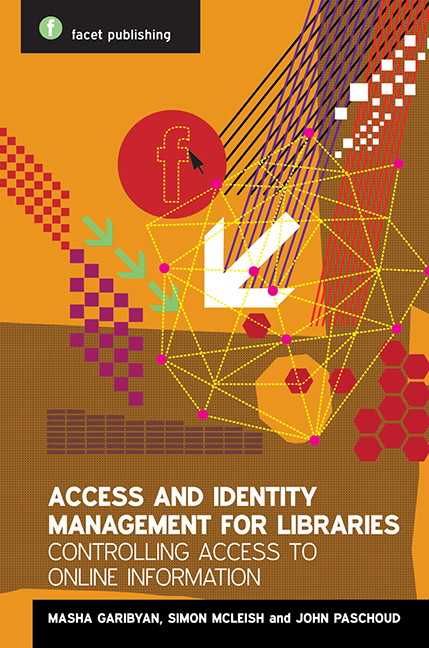Book contents
- Frontmatter
- Contents
- Foreword
- Acknowledgements
- Note to readers
- Glossary
- 1 What is access management, and why do libraries do it?
- 2 Electronic resources: public and not so public
- 3 Principles and definitions of identity and access management
- 4 Current access management technologies
- 5 Authentication technologies
- 6 Authorization based on physical location: how does the internet know where I am?
- 7 Authorization based on user identity or affiliation with a library: who you are? Or what you do?
- 8 Federated access: history, current position and future developments
- 9 How to choose access management and identity management products and services
- 10 Internet access provided by (or in) libraries
- 11 Library statistics
- 12 The business case for libraries
- Afterword
- Appendix 1 Case studies
- Appendix 2 A White Paper on Authentication and Access Management Issues in Cross-organizational Use of Networked Information Resources
- Index
2 - Electronic resources: public and not so public
Published online by Cambridge University Press: 10 September 2022
- Frontmatter
- Contents
- Foreword
- Acknowledgements
- Note to readers
- Glossary
- 1 What is access management, and why do libraries do it?
- 2 Electronic resources: public and not so public
- 3 Principles and definitions of identity and access management
- 4 Current access management technologies
- 5 Authentication technologies
- 6 Authorization based on physical location: how does the internet know where I am?
- 7 Authorization based on user identity or affiliation with a library: who you are? Or what you do?
- 8 Federated access: history, current position and future developments
- 9 How to choose access management and identity management products and services
- 10 Internet access provided by (or in) libraries
- 11 Library statistics
- 12 The business case for libraries
- Afterword
- Appendix 1 Case studies
- Appendix 2 A White Paper on Authentication and Access Management Issues in Cross-organizational Use of Networked Information Resources
- Index
Summary
Many libraries around the globe need to manage access to a variety of internal and external online resources and services, such as proprietary journals and databases, the organization's own resources and data. User permissions information contained in licensing agreements is sometimes unclear and complicated, and so it needs to be managed carefully in order to ensure that users are given access to everything they are entitled to. In addition, users now expect to be able to access online resources irrespective of time and the users’ physical location. This chapter looks at the different kinds of online information that need to be protected, the reasons why, and the importance of effective library management of licensing information.
The primary purpose of information services has always been and will always be to reduce to a minimum the amount of time required by local users to obtain access to that information they need to do their work.
R. Atkinson (in Woodward and McKnight, 1995, 71)Managing access to electronic collections
Many libraries around the world need to manage an ever-increasing number of electronic resources. Library collections are no longer confined to the physical boundaries of the library and are seeing rapid growth thanks to the incredible selection of quality electronic resources that are now available. While it is impossible for any library to own everything that its users want, electronic resources have opened up opportunities for providing access to a resource while not actually owning it (Moyo, 2002, 49).
Managing access to electronic collections in the ‘global electronic information market’ (Steele, in Moyo, 2002, 48) faces a number of serious challenges. Back in 1998, Steele suggested that this new information market would have the following features:
• ubiquitous desktop access
• tailored and flexible gateways to information
• ease of access to information with no location barrier
• interchangeability, interoperability and compatibility
- Type
- Chapter
- Information
- Access and Identity Management for LibrariesControlling Access to Online Information, pp. 9 - 20Publisher: FacetPrint publication year: 2014



